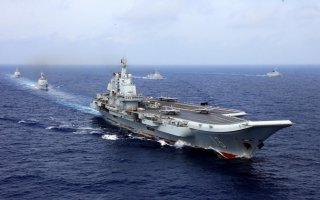The Ultimate Weapon: Could China's Aircraft Carrier One Day Be Nuclear?
Will the People’s Liberation Army Navy (PLAN) ever take the leap into nuclear propulsion for its aircraft carriers?
Here's What You Need to Remember: Credible reports confirm that the PLAN is already building at least one conventional carrier in the 80,000-ton range. Given how quickly Chinese shipbuilding has accelerated, does it make sense for the PLAN to think nuclear for its next generation of ships?
Credible reports confirm that the PLAN is already building at least one conventional carrier in the 80,000-ton range. Given how quickly Chinese shipbuilding has accelerated, does it make sense for the PLAN to think nuclear for its next generation of ships?
You May Also Like: 5 Best Submarines of All Time, 5 Best Aircraft Carriers of All Time, 5 Best Battleships of All Time and Worst Submarine of All Time.
Current Carriers
China has taken huge steps forward in the past decade, acquiring and modifying an old Soviet carrier, and building a new ship to the same design. China will follow up the Type 001— essentially a half-sister to Liaoning, itself a half-sister to Admiral Kuznetsov—with the Type 002. Reportedly already under construction, the Type 002 is expected to use conventional propulsion, along with a series of technological advances such as an EMALS (Electromagnetic Aircraft Launch System) catapult system.
Also From TNI: Donald Trump: The Worst President Ever?
Also From TNI: Donald Trump: Best President Ever?
Also From TNI: Why Japan Really Lost Pearl Harbor
It is unclear how many Type 002 carriers Beijing will build, although a one-off would be uncharacteristic of Chinese shipbuilding. It makes sense that the PLAN would want a pair of ships; operating the CATOBAR (Catapult Assisted Take-Off But Arrested Recovery) Type 002 carriers will require a significantly different skill set than the first two, and it will be easier to produce that skill set with two carriers than with one. Moreover, the construction of only a single carrier could make that ship a white elephant, sitting uneasily in China’s larger strategic plan.
Nevertheless, some reports have suggested that China will take the nuclear leap for its fourth carrier. The Type 003, which largely remains on the drawing board, represents China’s real leap into the void. Expected to displace 110,000 tons, the Type 003 carriers will be the first ships since the 1950s built anywhere in the world to rival the largest, most powerful U.S. supercarriers. Although detailed expectations for the ships are not yet available, a vessel of that size could probably make thirty knots and carry in excess of seventy aircraft—much like the Nimitz or Gerald Ford classes in the United States. Experience with the Type 001 and Type 002 ships will undoubtedly feed back into the design and construction process to produce a more efficient, effective vessel. It remains unclear what kind of aircraft the Type 003 might fly, but a next generation of fighters and drones (the former perhaps based on the J-31 stealth fighter) should be available by the time the first Type 003 takes to the sea.
Why Go Nuclear?
Depending on a few strategic factors, nuclear power could make sense for the PLAN. Unlike the U.S. Navy (USN), the PLAN does not yet have access to a bewildering array of bases and maintenance facilities that can keep a carrier battle group in fighting trim. Similarly, the PLAN lacks the experience of the USN in long-range underway replenishment. A nuclear carrier doesn’t solve these problems—escorts will still need fuel, and the air group will still burn through equipment and fuel at a high rate—but a carrier that can travel long distances without refueling can help on the margins.
The other reason that nuclear power could be useful is the potential for huge power generation. Projections suggest that this will increasingly become a requirement for advanced warships, as they will depend upon lasers and other power-hungry systems for defensive and offensive weapons. It is not inconceivable, if testing and development go well, that China’s first nuclear carrier could carry lasers, railguns and other such advanced equipment.
With respect to strategic rationale, China’s maritime lines of communication lie in the Pacific and Indian Oceans. In the latter especially, China faces potentially hostile foreign powers (India, France the United Kingdom) on turf that geographically favors those countries. As the core of a task force made of cruisers, destroyers and nuclear attack submarines, a Type 003 carrier could offer a formidable presence—likely more formidable than that of any navy besides the USN. Moreover, as U.S. experience has demonstrated, large aircraft carriers are extremely flexible platforms, and can support all manner of expeditionary operations beyond their intended functions. Big decks with big reactors offer a nation reliable tools for resolving its security concerns.
Conclusion
More than a generation ago, some analysts predicted that the Soviet Union might build aircraft carriers to rival the largest ships in the U.S. Navy. This would have represented a natural progression from helicopter carriers, to V/STOL (vertical and/or short take-off and landing) carriers, to ski-jump carriers and finally to genuine CATOBAR supercarriers. Even the Soviets bought into the idea, putting together plans for massive carriers that could have challenged the USN on the high seas.
Alas, it was not to be. The Soviet Union collapsed, and its naval ambitions collapsed with it. And unexpected events might change China’s evolution, as well. The People’s Republic of China (PRC) might suffer an economic downturn that would render its carrier fleet too expensive to push forward. China might decide that aircraft carriers aren’t worth the risk, given improvements in the technologies designed to destroy them. But at the moment, the PRC has decided to allow the PLAN to push forward with an extremely ambitious carrier program, one that could eventually produce a fleet second only to the USN, and that perhaps only for a time.
Robert Farley, a frequent contributor to the National Interest, is author of The Battleship Book.
Image: Reuters

